História do cliente: Granger Construction

Equipe Design-Build alcança o primeiro data center em Michigan
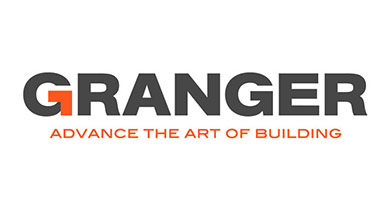
Visão geral
Projetos complexos como data centers normalmente não adotam uma abordagem de projeto-construção. Mas em 2019, os membros da equipe daGranger Construction, Integrated Design Solutions (IDS), IBI Group, Motor City Electric e Conti Corporation fizeram história à medida que seu projeto de data center de construção de projeto se tornou o primeiro no estado de Michigan a receber a Tier Tier III Certification do Uptime Institute para instalações de projeto e construção.
Este projeto não só foi o primeiro do tipo concluído no estado, como o proprietário também incumbiu a equipe de concluir a fase de projeto dentro de um sprint desafiador de 12 semanas e construção em pouco mais de um ano. No estudo de caso a seguir, a equipe de projeto compartilha as melhores práticas e lições aprendidas com sua experiência.
Um projeto desafiador
“Ao projetar este projeto, enfrentamos muitos desafios além do planejamento para a certificação Tier III”, observou a gerente sênior de projetos da Granger, Joanne Kulbacki.
Múltiplos tomadores de decisão: Como um data center corporativo para um cliente internacional da Fortune 500, este projeto incluiu várias partes interessadas cujos interesses precisávamos coordenar. O Proprietário tinha muitos indivíduos envolvidos na aprovação de cada decisão, incluindo líderes de seu grupo de TI, projeto de instalações, engenharia, segurança e divisões de gestão de risco.
Cronograma agressivo: As metas do Proprietário para o cronograma de projeto eram muito ambiciosas. A solicitação de proposta (Request for Proposal, RFP) pediu uma abordagem de projeto-construção com base em critérios limitados e não incluiu desenhos. O Proprietário também propôs um cronograma de projeto de 12 semanas e nos pediu para desenvolver uma estratégia operacional para concluir o projeto de acordo com os critérios de RFP limitados.
Novos padrões: Normalmente, os projetos de projeto-construção são projetados com base nos requisitos do projeto descritos na RFP, com pouca contribuição adicional do proprietário. No entanto, esse projeto foi o primeiro data center do proprietário e eles queriam garantir que ele fosse projetado e construído de acordo com os mais recentes padrões do setor. Eles também queriam maximizar a flexibilidade para futuras inovações em tecnologia da informação, permitindo que usassem esse design como um modelo para futuros data centers. Para isso, nossa equipe precisava ajudar o Proprietário a estabelecer padrões e especificações de projeto para uma categoria de construção completamente desconhecida. No final, nós os orientamos com sucesso em 39 decisões críticas de design.
Uma das decisões de projeto mais críticas foi o sistema de fonte de alimentação ininterrupta (UPS). Isso não apenas influenciou o layout e o tamanho da instalação, mas também permitiu que o equipamento UPS fosse comprado durante a fase de projeto, o que ajudou a reduzir o cronograma de construção.
A solução
“Projetar um data center corporativo em apenas 12 semanas é uma tarefa quase impossível”, continuou Kulbacki. “Mas o maior motivo pelo qual nossa equipe foi bem-sucedida foi nossa estratégia operacional e agilidade.”
Lote de três semanas: Para começar, organizamos todas as decisões críticas de projeto em uma série de lotes de fluxo de trabalho que passaram por um processo de decisão de três semanas. Semana um, apresentamos um novo item ao Proprietário que precisava de uma decisão e, juntos, discutimos várias opções ou soluções a serem apresentadas em detalhes na semana seguinte. Na segunda semana, apresentamos uma análise detalhada dessas opções, incluindo o custo. Semana três, respondemos a qualquer uma das perguntas pendentes do proprietário. Em seguida, o proprietário decidiu sobre uma opção ou solução. A cada semana, a equipe iniciou um novo lote de decisões ao longo do ciclo e, na semana três de cada ciclo, finalizamos as decisões de projeto.
“A capacidade dos parceiros da equipe de projeto de dar um passo atrás com uma mente aberta e analisar objetivamente as necessidades do data center do proprietário à medida que novos conceitos estavam sendo avaliados, pesando a funcionalidade, orçamentando e validando metas de longo prazo, foi fundamental para alcançar um projeto bem-sucedido”, acrescentou o membro da equipe da Motor City Electric, Ray Fortier.
O sistema UPS foi um dos primeiros itens que apresentamos. Na primeira semana, trabalhamos com o Proprietário para estabelecer várias opções de nobreaks, incluindo nobreaks estáticos baseados em transformadores, nobreaks estáticos sem transformadores, nobreaks rotativos e várias opções de energia armazenada, incluindo baterias de chumbo-ácido ventiladas (VLA), baterias de chumbo-ácido reguladas por válvula (VRLA) e volantes. Apresentamos nossa análise na segunda semana, e o Proprietário tomou uma decisão na terceira semana. O processo de lote de três semanas permitiu que o Proprietário tomasse uma decisão informada sobre um tópico muito complexo em um tempo relativamente curto, permitindo-nos comprar o equipamento UPS no início da fase de projeto.
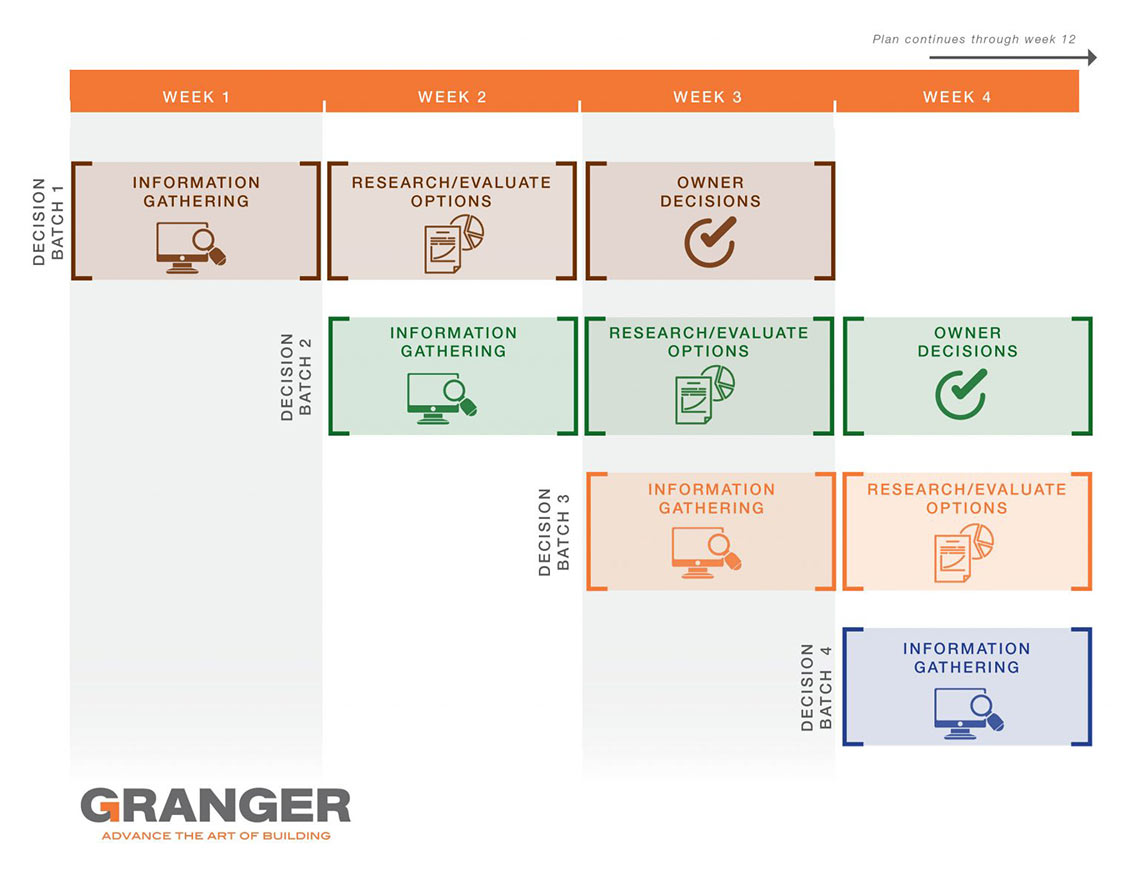
Fluxo de reuniões semanais: Ao longo de cada ciclo de três semanas, também usamos um fluxo de reunião semanal eficaz. Toda terça-feira, nossa equipe de design se reunia com o Proprietário para:
- Revisar o orçamento
- Medir nosso progresso no processo de design
- Apresentar as opções de projeto descritas no plano de lote de três semanas
- Tomar decisões críticas necessárias naquela semana
Realizamos uma pesquisa plus/delta no final de cada reunião para garantir que estávamos agregando valor a cada semana. Nas quartas-feiras, nossa equipe de 25 profissionais (engenheiros e parceiros comerciais) definiu a agenda para a reunião de terça-feira seguinte com base no plano de 12 semanas e em qualquer feedback do proprietário. Em seguida, realizamos sessões de discussão específicas da disciplina de acordo com a agenda, onde desenvolvemos soluções/opções que incluíram análise de custo, cronograma e custo de propriedade. No restante da semana (quinta a segunda-feira), usamos reuniões curtas com duração de 15 a 60 minutos para terminar de preparar as apresentações para as reuniões de proprietários de terça-feira.
“Essas reuniões de equipe de projeto multidisciplinares e de ciclo rápido eliminaram uma mentalidade de fim de fase e permitiram a análise da capacidade de construção lado a lado com as decisões de projeto”, declarou o gerente de projeto da IDS, David Giroux, AIA. Esse padrão semanal também manteve a equipe focada e coordenada, ao mesmo tempo em que definiu um precedente no início do projeto para uma tomada de decisão rápida e eficiente.
Participação principal: “Um dos maiores fatores para o sucesso com nosso fluxo de trabalho de projeto foi ter as pessoas certas na sala quando precisávamos delas, bem como a excelente coordenação e química entre o proprietário, o gerente de construção, a equipe de projeto e os parceiros comerciais”, acrescentou o engenheiro elétrico da IDS, Justin Kiriazis, PE. Nossa equipe de design tinha especialistas da Motor City Electric, Conti Corporation e outros parceiros comerciais e fornecedores para enfrentar desafios específicos na preparação para as reuniões de proprietários de terça-feira. Isso significava que poderíamos ter discussões contínuas sobre a capacidade de construção durante toda a fase de projeto, juntamente com o acesso a informações de custo contínuas e precisas com base nas opções de projeto propostas.
Por exemplo, o diretor mecânico da Conti Corporation, Vic Calleja e Sr. O estimador mecânico Jon Tkac observou que foi especialmente eficaz poder trabalhar com a equipe desde o início para obter feedback valioso sobre os requisitos do sistema mecânico.
“Depois de identificar as necessidades mecânicas do Proprietário, como a capacidade de megawatts necessária, nós combinamos um sistema mecânico para obter o resfriamento adequado necessário, juntamente com redundância no caso de qualquer tipo de falha catastrófica, para garantir que o equipamento operará sem pular um batimento. Trabalhando com nossos parceiros de equipe, conseguimos realizar essa tarefa monumental e criamos nosso projeto mecânico final que alcançou os requisitos de certificação Tier III do Uptime Institute.”
Ter as pessoas certas na sala no momento certo contribuiu muito para a análise eficaz e precisa das opções de projeto apresentadas, decisões rápidas do proprietário e tempo de inatividade zero durante a fase de projeto. A estreita coordenação entre nossa equipe de projeto e parceiros comerciais e as decisões rápidas do Proprietário nos permitiram comprar equipamentos e iniciar os esforços de construção durante a fase de projeto, ajudando-nos a cumprir o cronograma de construção apertado. Ao definir uma agenda detalhada para as reuniões semanais do Proprietário, o Proprietário teve uma grande participação de seus especialistas no assunto e tomadores de decisão durante todo o processo; ter os representantes certos do Proprietário na sala, semana após semana, foi fundamental para alcançar uma resposta rápida em decisões complexas.
Comunicação visual
“Outro chave para o sucesso da nossa equipe foi a utilização de várias ferramentas de comunicação visual, afirmou Kulbacki. Com tantos tomadores de decisão e partes interessadas envolvidas, precisávamos garantir que até mesmo os detalhes técnicos mais especializados fossem comunicados de uma maneira que todos pudessem entender. Para isso, usamos diagramas/fotos simples para cobrir uma variedade de tópicos e garantir a mesma compreensão entre todos os participantes do Proprietário, independentemente da área de especialização.
Modelos BIM: “A Modelagem de Informação da Construção (BIM) tornou-se um padrão para projetos em todos os setores, e nossa equipe achou essa ferramenta de comunicação visual especialmente eficaz para coordenar as vastas complexidades da infraestrutura mecânica e elétrica neste projeto de data center em ritmo acelerado”, observou Scott Batzold, engenheiro elétrico da IDS, PE. A documentação da nossa equipe e a precisão da modelagem BIM tornaram-se fatores críticos para permitir o progresso da construção sem inibição.
A equipe usou o BIM para executar detecções de conflitos, coordenar projetos comerciais e apresentar conceitos de projeto ao proprietário. O BIM também nos permitiu comparar escolhas e responder perguntas sobre as opções propostas. Por exemplo, usamos o BIM para explorar o layout do data hall e determinar a melhor rota de acesso à tubulação de água resfriada sob o piso e pontos de acesso para manutenção.
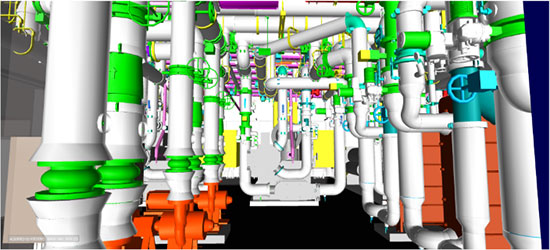
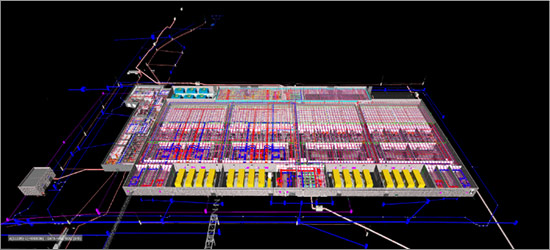
Escolhendo por vantagem: À medida que percorremos o processo em lote de três semanas, nossa equipe de projeto usou o Chooseing by Advantages (CBA) para ajudar o proprietário a chegar às decisões sobre os tópicos complexos. Por exemplo, ao escolher o sistema UPS, o Proprietário recebeu uma matriz CBA com cinco opções de UPS e atributos listados para cada opção com base em nove categorias de atributos. Os atributos receberam pontos ponderados com base na importância para o proprietário. Um gráfico dos resultados do CBA e o custo total de propriedade permitiu que o proprietário visse visualmente que a opção de volantes era a melhor solução. O processo CBA fez com que o Proprietário se sentisse mais confiante em suas decisões e ajudou a simplificar o processo de tomada de decisão.
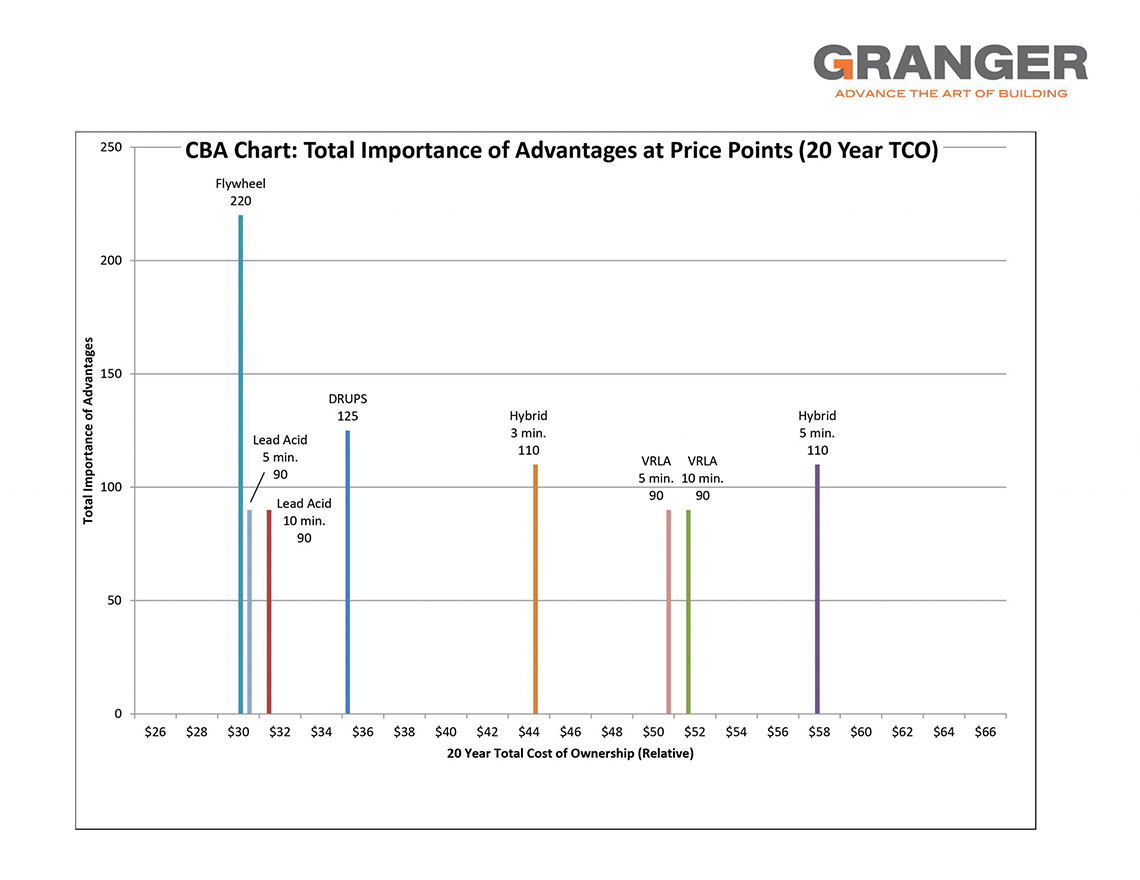
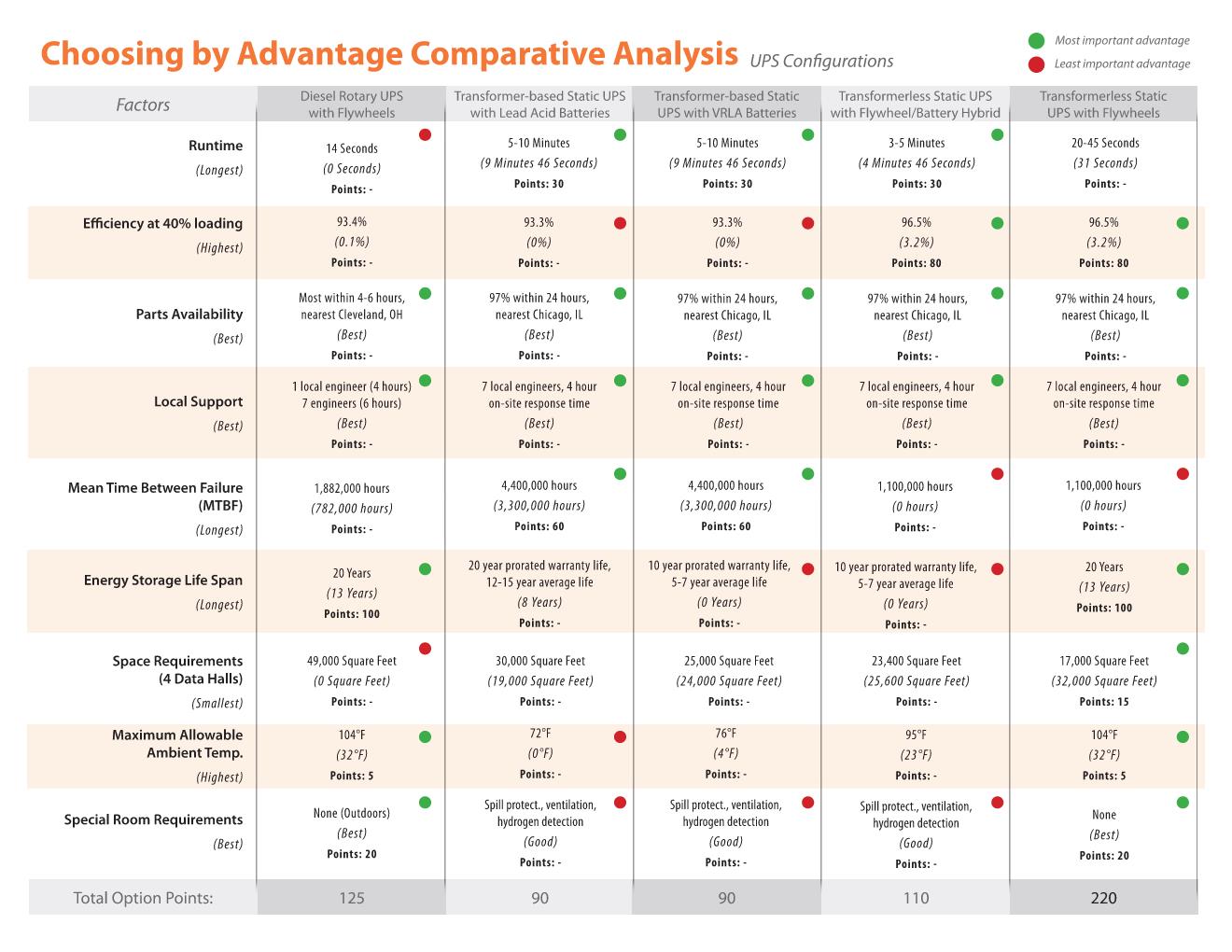
Apresentações: Criamos apresentações visualmente ricas para ilustrar o conteúdo real do design para o proprietário toda semana. Isso ajudou a garantir a compreensão universal de conceitos complexos de design em um público grande e diversificado, facilitando decisões mais rápidas.
Painéis: Usamos um layout de painel para rastrear as principais métricas, participação semanal em reuniões e progresso em direção às metas. Neste projeto, as principais métricas incluíram pontos de certificação LEED e etapas de certificação Tier III do Uptime Institute alcançadas até o momento. Atualizamos este painel antes de cada reunião semanal do proprietário para refletir os números mais recentes.
Metas, funções e contingências
“Nossa equipe está orgulhosa do que realizamos com este projeto desafiador de design-construção”, observa Kulbacki. “Mas uma grande conclusão que aprendemos e enfatizaríamos para as futuras equipes de projeto é planejar amplas contingências para quando as coisas mudarem.”
Dissipe o equívoco de que não há espaço para mudar de ideia ou alterar decisões/projetos com uma abordagem de projeto e construção. As coisas mudam em cada projeto, e a melhor prática é criar um plano de contingência para absorver essas mudanças. É vital estabelecer metas claras e principais tomadores de decisão no início do período de projeto. No entanto, você precisa revisitar e recalibrar essas metas e esclarecimentos de função à medida que o projeto e a construção do data center progridem. Assim como qualquer coisa em tecnologia, o que é ótimo hoje pode ser ultrapassado amanhã!
Comece na reunião inicial do projeto explicando por que é importante definir claramente as funções/responsabilidades individuais e designar os tomadores de decisão finais.
O proprietário pode não saber exatamente o que quer no início do projeto, ou pode haver lacunas de informações na RFP, portanto, você precisa esclarecer essas coisas no início do processo de design para que todos estejam na mesma página daqui para frente.
Isso é especialmente verdadeiro para quem se esforça para obter a Tier Tier Certification do Uptime Institute. Primeiro, você deve chegar a um acordo com o proprietário e toda a equipe sobre quais elementos de certificação buscar e, em seguida, determinar se há um desejo e disponibilidade de orçamento para aprimorar qualquer um dos sistemas para um nível de Tier mais alto para confiabilidade adicional.
Certificação e sucesso
“Nossa abordagem de projeto-construção, fluxo de trabalho e sinergia de equipe nos permitiu adotar um cronograma de projeto agressivo e obter não apenas a Certificação Tier III para projeto, mas também para construção”, disse Kulbacki.
“O processo de Certificação Uptime Tier foi inestimável para o sucesso do nosso projeto”, observa Kiriazis. “O consultor sênior Scott Good foi além para ajudar nossa equipe de projeto a navegar pelos Tier Standards durante o projeto e a construção da instalação. Sua experiência garantiu que as expectativas do cliente para uma instalação Tier III de alta qualidade fossem atendidas.
“Foi uma honra fazer parte de um feito monumental único”, acrescentou Calleja e Tkac.
A equipe manteve a diversão, a camaradagem, o engajamento e a empolgação durante todo o projeto. Isso, além da atitude de todos “podem fazer” e do compromisso de garantir a experiência e as respostas, foram fundamentais para o sucesso. Também tivemos um ótimo processo de integração à medida que o projeto progrediu, permitindo-nos manter o foco no design à medida que o tamanho da equipe crescia.
Embora agressivos, há muitos aspectos desse processo de projeto que incentivamos outras equipes de projeto a implementar em seu projeto. Já os implementamos em uma instalação irmã para o mesmo cliente Fortune 500.
Temos a honra de ser a primeira equipe em Michigan a usar o Design-Build com essa estratégia operacional e obter essas duas certificações e nos juntar ao grupo de mais de 60 data centers nos EUA que receberam a Tier III Certification for Design Documents (TCDD) do Uptime Institute e a Tier Certification of Constructed Facility (TCCF) para data centers concluídos.
